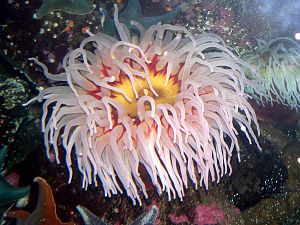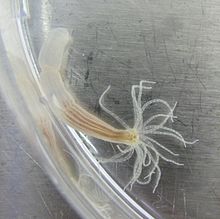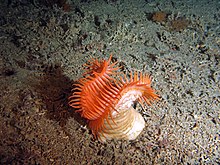Sea anemones
| Sea anemones | ||||||||||||
|---|---|---|---|---|---|---|---|---|---|---|---|---|

Fish-eating sea dahlia ( Urticina piscivora ) |
||||||||||||
| Systematics | ||||||||||||
|
||||||||||||
| Scientific name | ||||||||||||
| Actiniaria | ||||||||||||
| Hertwig , 1882 |
Sea anemones (Actiniaria), also called water lilies , sea carnations or actinias , are a species-rich and generic order of the Hexacorallia within the flower animals (Anthozoa). They are exclusively living in the sea, always solitary , mostly relatively large animals that occur from shallow water to abyssal depths. About 1200 species are currently known.
features
Sea anemones have no skeleton and live solitary , i. That is, they do not form colonies in contrast to most other representatives of the flower animals. You are semi-sessile ; they can move by slowly crawling on their footplate, which they normally use to cling to hard ground or dig into sand and rubble. Your body is muscular. The size can range from one to 150 centimeters, depending on the species. Their tentacles are simple and usually not branched, and often translucent. Some species have nettle threads , here called acontia , which are ejected through the mouth or through pores in the scapus, so-called cinclidia. Various forms of modes of reproduction are known. Separate, but also hermaphroditic species exist. There is even a cross-division or constriction of the foot sections.
Geographical occurrence, distribution and way of life
There are over 1200 species in all seas from shallow water to 10,000 m depth. About 60 species are found in European waters. Many adult actinia eat fish , crabs and snails , others only plankton .
Symbioses
Some species form symbioses with other animals. So find z. B. anemonefish , the anemone goby , spider crabs or partner shrimp between the tentacles protection from enemies, or hermit crabs attach the parasite rose to the snail shells they inhabit ( ectosymbiosis ).
Systematics
A current system divides the sea anemones on the basis of a phylogenetic investigation, in which two genes from mitochondrial DNA and three genes from the cell nucleus of 123 different sea anemone species were compared with one another, into two sub-orders and five superfamilies.




-
Sea anemones (Actiniaria)
- Subordination Anenthemonae
- Superfamily Edwardsioidea
- Edwardsiidae Andres family , 1881
- Superfamily Actinernoidea
- Family Actinernidae Stephenson, 1922
- Family Halcuriidae Carlgren, 1918
- Superfamily Edwardsioidea
- Subordination Enthemonae
- Superfamily Actinostoloidea
- Family Actinostolidae Carlgren, 1932
- Exocoelactiidae family Carlgren, 1925
- Superfamily Actinioidea
- Family Actiniidae Rafinesque, 1815
- Family Actinodendridae Haddon, 1898
- Family Andresiidae Stephenson, 1922
- Family Capneidae Gosse, 1860
- Family Condylanthidae Stephenson, 1922
- Family Haloclavidae Verrill, 1899
- Family Homostichanthidae Carlgren, 1900
- Family Iosactinidae Riemann-Zürneck, 1997
- Limnactiniidae family Carlgren, 1921
- Family Liponematidae Hertwig, 1882
- Family Minyadidae Milne Edwards, 1857
- Family Oractinidae Riemann-Zürneck, 2000
- Family Phymanthidae Andres, 1883
- Family Preactiniidae England in England & Robson, 1984
- Family Ptychodactiidae Appellöf, 1893
- Family Stichodactylidae Andres, 1883; including 7 out of 10 symbiotic anemones
- Thalassianthidae family Milne Edwards, 1857
- Superfamily Metridioidea
- Family Acontiophoridae Carlgren, 1938
- Family Actinoscyphiidae Stephenson, 1920
- Family Aiptasiidae Carlgren, 1924
- Family Aiptasiomorphidae Carlgren, 1949
- Aliciidae family Duerden, 1895
- Family Amphianthidae Hertwig, 1882
- Family Andvakiidae Danielssen, 1890
- Family Antipodactinidae Rodríguez, López-González, Daly, 2009
- Bathyphelliidae family Carlgren, 1932
- Family Boloceroididae Carlgren, 1924
- Family Diadumenidae Stephenson, 1920
- Family Gonactiniidae Carlgren, 1893
- Family Halcampidae Andres, 1883
- Family Haliactinidae Carlgren, 1949
- Family Haliplanellidae hand, 1956
- Family Hormathiidae Carlgren, 1932
- Isanthidae family Carlgren, 1938
- Family Kadosactidae Riemann-Zürneck, 1991
- Family Metridiidae Carlgren, 1893
- Family Mimetridiidae
- Family Nemanthidae Carlgren, 1940
- Family Nevadneidae Carlgren, 1925
- Family Octineonidae Fowler, 1894
- Family Ostiactinidae Rodríguez et al., 2012
- Family Phelliidae
- Family Ramireziidae Fautin, Eppard & Mead, 1988
- Sagartiidae family Gosse, 1858
- Family Sagartiomorphidae Carlgren, 1934
- Superfamily Actinostoloidea
- Subordination Anenthemonae
Individual evidence
- ^ Bernhard Werner: Tribe Cnidaria . In: Textbook of Special Zoology. Volume I: Invertebrates Part 2: Cnidaria, Ctenophora, Mesozoa, Plathelminthes, Nemertini, Entoprocta, Nemathelminthes, Priapulida. 4th completely revised edition, pp. 11–305, Gustav Fischer Verlag, Stuttgart 1984 ISBN 3-437-20261-8
- ↑ Estefania Rodriguez, Marcos S. Barbeitos, Mercer R. Brugler, Louise M. Crowley, Alejandro Grajales, Luciana Gusmao, Verena Häussermann, Abigail Reft, Marymegan Daly: Hidden among Sea Anemones: The First Comprehensive Phylogenetic Reconstruction of the Order Actiniaria (Cnidaria , Anthozoa, Hexacorallia) Reveals a Novel Group of Hexacorals. PLOS ONE , May 2014, Volume 9, Issue 5, e96998, DOI: 10.1371 / journal.pone.0096998 .
literature
- Harry Erhardt, Horst Moosleitner: Sea water atlas. Volume 1 Mergus-Verlag, Melle 2006, ISBN 3-88244-020-1 .
Web links
- Actiniaria in the Integrated Taxonomic Information System (ITIS)
- Bryan McCloskey: Illustrated Glossary of Sea Anemone Anatomy ( Memento of March 5, 2015 in the Internet Archive )
- Sea Anemones - Actiniaria - Sea Anemones. Photos of different sea anemone species from a coral reef

